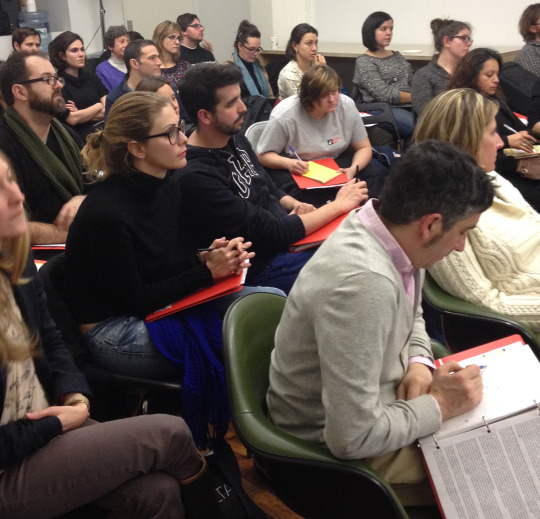Recap | Legal Primer for Visual Artists: Copyright, Fair Use, and Gallery Agreements
Visual artists, do you know your rights? Learn best practices on common legal issues from several arts law experts.
What is copyright, and what is the scope of your copyright rights as an artist? What is “fair use,” and how does it affect your ability to use other people’s content in your work? How does an artist navigate agreements with galleries?
Sponsored by the New York City Bar Association’s Art Law Committee and the New York Foundation for the Arts, this legal workshop for visual artists was conducted at the Hometown Gallery in Bushwick, Brooklyn on Wednesday, May 3, 2017. Judith L. Church, Esq., Counsel to Debevoise & Plimpton LLP, Irina Tarsis, Esq., Founder and Director of the Center for Art Law, and Betsy Dale, Esq., Staff Attorney for Volunteer Lawyers for the Arts shared their expertise on copyright, fair use, and gallery agreements. The event was moderated by Carol Steinberg, Esq., Law Firm of Carol J. Steinberg & Professor, School of Visual Arts, and Adam Yokell, Esq., Owner and Director of Hometown Gallery. Below are key takeaways from the discussion.
Copyright and Fair Use
Copyright protects original works of authorship fixed in a tangible medium, so ideas are not protectable, but an expression of an idea is. If you have a great idea for a new project, but it is not yet embodied in tangible form, it’s not copyrightable.
Copyrights are generally owned by the people who create the works of expression, with some important exceptions. For example, if a work is created by an employee in the course of his or her employment, the employer owns the copyright. This means artists usually own the copyright of their creations, except under the “work made for hire” doctrine.
What exclusive rights does the copyright owner have?
- The right to reproduce the copyrighted work
- The right to prepare derivative works based upon the work
- The right to distribute copies of the work to the public
- The right to perform or display the copyrighted work publicly
The copyright owner has a bundle of rights, which can be licensed or assigned to other parties, but copyright does not travel with the object unless stated otherwise in the contract. Specifically as an artist, when you sell an artwork you keep the copyright of the work, even though the buyer owns the actual artwork, but you may agree to transfer the display right to the gallery.
Is it necessary to register a copyright?
Copyright protection is automatic. Your artwork is under copyright protection the moment it is created and fixed in a tangible form. However, copyright registration is recommended. It helps you build up the facts of public record, and you may be eligible for statutory damages and attorney’s fees in successful litigation.
What are the factors to consider in deciding whether use of copyrighted material is fair use?
- Purpose and character of the use: Why are you using another person’s work in your creation? Is your work commercial in nature, or for non-profit educational use?
- Nature of the copyrighted work: The more creative the original is, the harder it is to justify its use in a derivative form by another artist. Is the underlying original more like a telephone book or like a very innovative, hard-to-describe thing?
- Amount and substantiality of the portion used: How much do you take from the original work? Are you borrowing the “heart” and the “core” aspect of the original work, just a small fraction, or the entire work?
- Effect of the use upon the potential market: Are you competing with the original work in the same market, or are you targeting a new one?
Fair use is a defense against claims of copyright infringement, so there would be comprehensive analysis of the four factors above to determine whether one’s use of another’s copyrighted material is “fair use.”
Fair use is also a right that has been used by appropriation artists to prevent copyright holders from interfering with their creative processes, such as writing plays based on well known cultural references: think Dr. Seuss and Andy Warhol.
Consignment Agreements
Artworks are commonly sold on consignment. In New York, once artists deliver the artwork to the gallery, the consignor-consignee relationship is established. The gallery becomes the artist’s agent.
Based on the New York Arts & Cultural Affairs Law, a gallery, now deemed an “agent” of the artist, must:
- Properly care for and manage the consigned work,
- Deal fairly and honestly,
- And avoid self-dealing.
Get it in writing
Having a written agreement is beneficial to both parties, as it will prevent misunderstanding, and can be used for future reference. Oral agreements are not advisable.
A Consignment agreement is a form of contract. In order to be a binding contract, it must:
- Evidence a “meeting of the minds” between two or more parties (i.e., offer and acceptance). The offer has to be specific enough to be accepted; the acceptance could be performed or confirmed verbally.
- Include consideration. Both sides must exchange something of value, like money, goods, or services.
- Not be vague, and,
- Not be illegal.
Clearly state the scope of the relationship
The agreement should explicitly state the artworks are being consigned, not sold. Some questions to consider:
- Does it mention representation? If so, is the gallery the exclusive agent, or non-exclusive?
- Do you consign all your artwork, or just a certain body of artwork, and/or future artworks?
- What’s the purpose of the consignment? The purpose is usually for exhibition and sale. Can the gallery loan the artwork to others?
- Are you signing with an individual or a company? Be sure to enter the agreement with the correct party, i.e., if with a gallery, don’t sign with the individual, but with the name of the company.
Other Tips:
- Before entering into the consignor-consignee relationship, do your homework to check the gallery’s reputation, what types of clients the gallery attracts, what types of market it reaches, and how long the gallery has been in operation.
- Be as thorough and detailed as possible in the consignment agreement. Don’t leave it vague.
- Specify the term of consignment, such as start and end date, delivery timeline, termination, renewal, etc.
- Don’t sign anything without reading it.
Resources
- Code of Best Practices in Fair Use for the Visual Arts, February 2015
- U.S. Copyright Office
- Creative Commons
- Stanford Copyright and Fair Use Center
– Judy Cai, Program Officer, NYFA Learning/Asian Affairs
This is a summary of a May 3, 2017 event, Legal Primer for Visual Artists: Copyright, Fair Use, and Gallery Agreements. This event was presented by NYFA Learning, which includes professional development for artists and arts administrators. To read more articles on this topic and others, check out NYFA’s Business of Art Directory. Sign up for NYFA’s free bi-weekly newsletter to receive updates on future programs.
Image: NYSCA/NYFA Artist as Entrepreneur Bootcamp workshop, 2014. Photo Credit: NYFA





